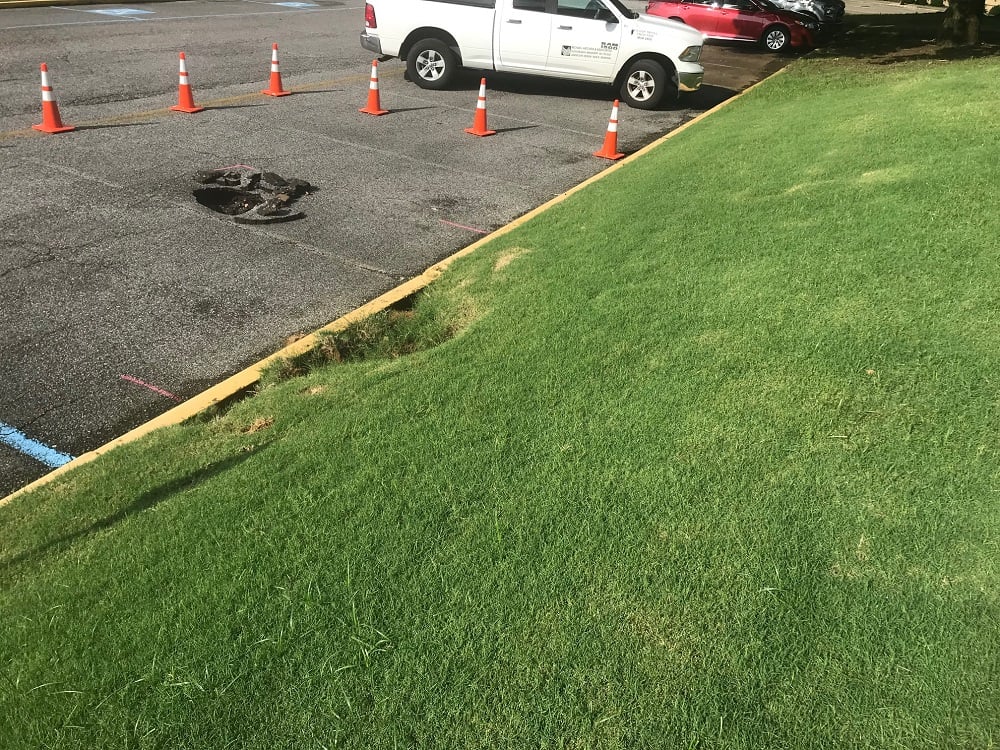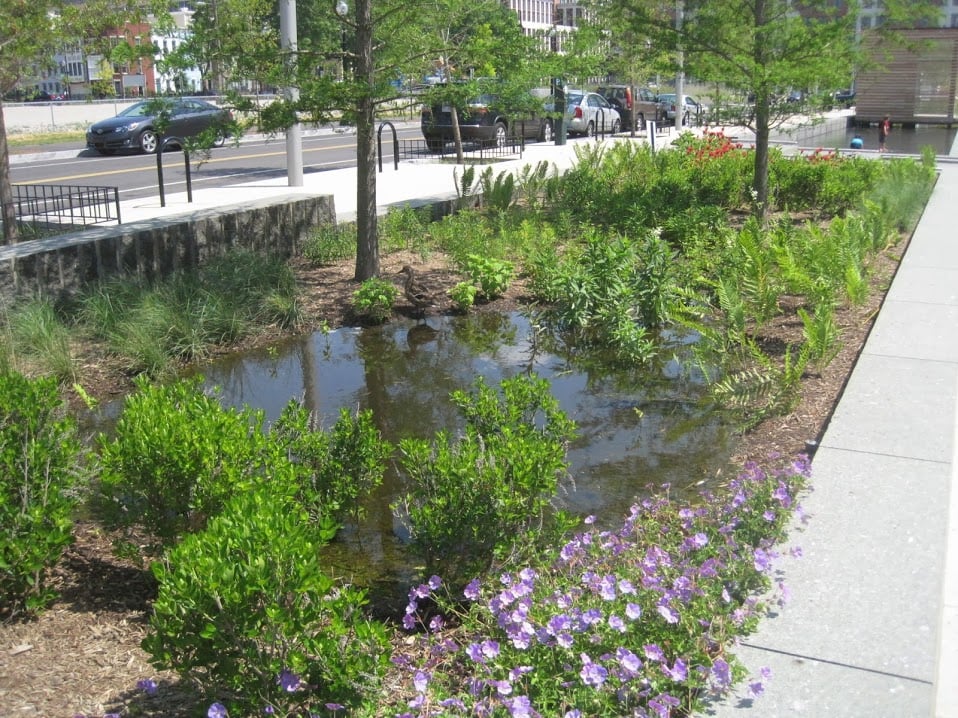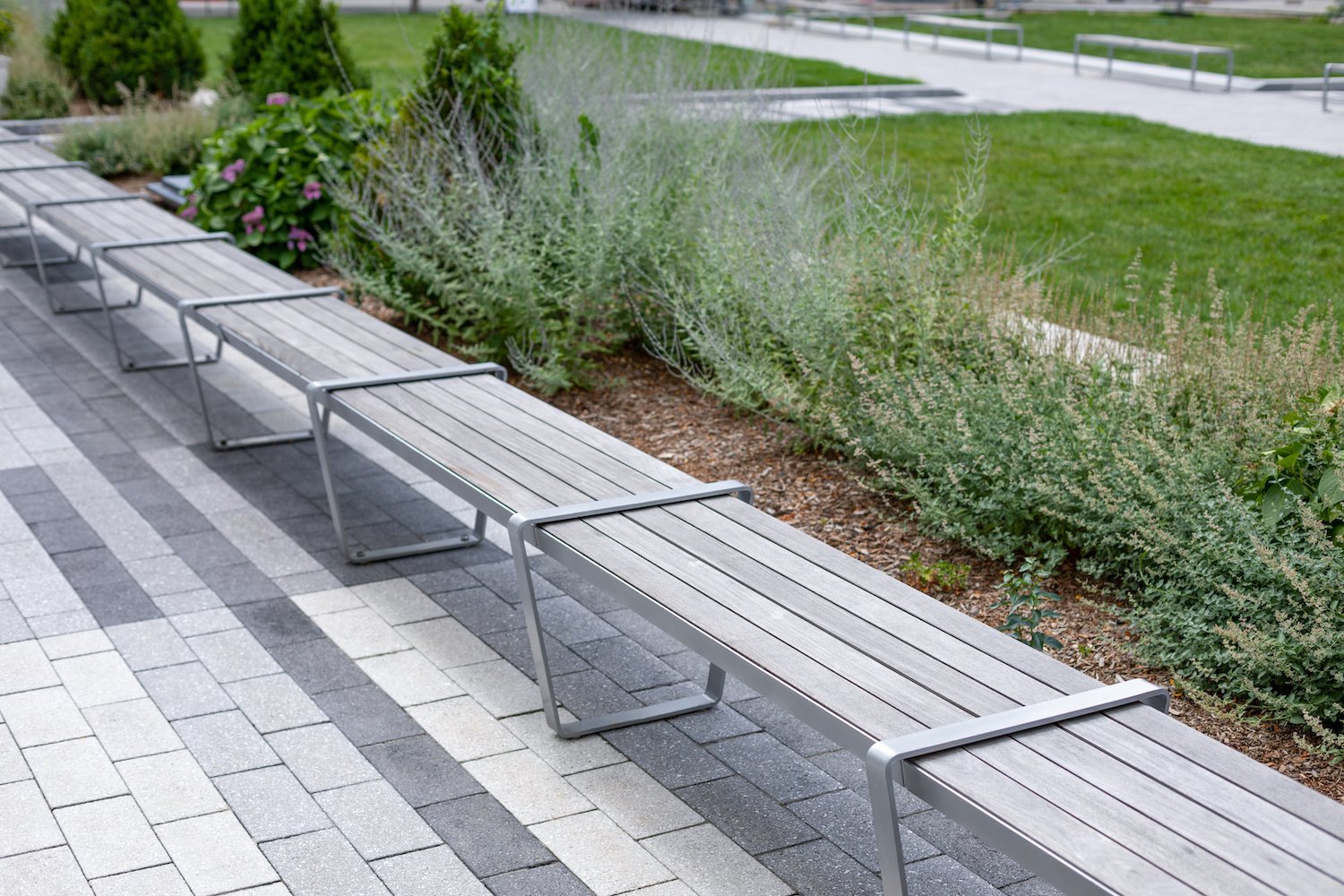If you have a large paved area around your industrial property, you might think you’re getting off easy.
No grass to mow, no mulch worries.
But the problem with pavement is that water runs off of it, not through it.
And that causes some erosion challenges.
Stephen Shikle, senior landscape architect at Hatcher & Associates, talks about the storm runoff and erosion problems that come with plenty of pavement — and how experts solve them.
Erosion
“The biggest obstacle is erosion,” Shikle says. Water often washes away the dirt at the edges of pavement.

“I’ve seen parking lots fail due to water not being handled,” he says. “We often have to re-do parking lots and walls damaged by too much water. Parking lots sink away, and big holes develop where water washed it out underneath.”
Erosion can take a toll on retention ponds, too, he says. Excess water can erode the pond edges, compromising how well the retention basin works.
Water Pollution
Pavement collects all kinds of pollutants: oil from vehicles, nitrogen oxides from car exhaust, bits of rubber from tires, phosphates from fertilizers, spilled antifreeze.
These pollutants can’t seep through a solid pavement surface, so they quickly end up flowing from your property right into the groundwater and nearby lakes and streams, threatening wildlife.
Flash Flooding
When heavy rain has nowhere to go but pavement, it can quickly trigger flooding.
Water runoff from an acre of pavement is 10 to 20 times greater than the runoff from an acre of grass.
The Big Deal About Drainage
The water runoff that occurs on big expanses of pavement can seriously damage your commercial property and make it unappealing to prospective customers, visitors and tenants.
Excess water will crack and erode pavement, as well as surrounding sidewalks, driveways and retaining walls.
Nearby buildings are at risk, too. Too much water creates mold and mildew and causes cracks in interior walls and exterior surfaces.
Excess water is a safety issue. Damaged, buckled concrete or asphalt is a trip hazard, which means it’s a liability issue for you.
And nobody wants to slog through deep puddles.
Expert Solutions for Erosion Control
Here’s a look at how Shikle and the Hatcher team fix wayward water on large paved areas:
Concrete Swales
Concrete swales are installed at the lowest point on your property, and gravity does the rest, collecting the water that flows off your paved area and directing it down these concrete channels where you want it to go.
Rain Gardens
A garden of water-loving grasses and native plants installed in a low area of your property will encourage storm water to soak slowly into the ground instead of flowing directly into storm drains.

A properly planted rain garden will filter out pollutants, then slowly release the cleaner water into the water table.
Retention Basins
A retention basin or storm water pond on your property will collect water from rain and runoff and release it slowly, preventing flooding or erosion.
But they need occasional maintenance. You can’t just forget about them.
Trash is often washed into these ponds, Shikle says, along with oils and other pollutants.
Adding the right plant material is crucial.
“The right plant material can slow down the water flowing in from the lot,” he says.
They also protect the pond by holding soil on the bottom and at the water’s edge, which reduces erosion.
Shikle likes rushes for this purpose, including bulrush, a tall, marsh-loving plant that acts as a filter, absorbing pollutants.
Shoreline plants like canna lilies do the trick, too. The showy, native plant grows naturally in wetlands so it’s right at home here.
Floating plants like water lilies are another Shikle favorite.
Re-grading Low Spots
Sometimes re-grading low spots can fix the problem, so that water flows away from buildings instead of pooling where it shouldn’t.
Permeable Materials
Newer landscape designs often include permeable materials rather than concrete or asphalt, Shikle says.

Porous concrete, permeable pavers and gravel systems allow water to filter through, rather than wash off the surface.
You’ll pay more for these materials, though, he notes.
“Asphalt is cheap,” he says. “And budget is often a concern.”
Do You Have A Water Problem?
If you have a large expanse of pavement, you might have water problems. Here’s what to look for:
- Rainwater gushing across your paved areas toward storm drains, rather than slowly seeping into the ground.
- Big puddles on your pavement that take days to evaporate.
- Areas of buckled asphalt or concrete.
- Moisture or mildew odor in the basements of nearby buildings.
- Water oozing up through cracks in the asphalt.
Lots of Pavement? Trust It to Hatcher
Water seems harmless enough, but too much of it on large paved surfaces can cause a lot of damage.
Address any problems sooner rather than later and you’ll avoid insurance issues and expensive repair bills.
And you won’t have to stress out when heavy rain hits.
Watch This Video to Learn How We Help Industrial Properties
“If you wait until a small problem becomes a big problem,” Shikle says, “then it’s expensive to repair.”
Are you ready to put your large expanses of pavement and their water issues in our skilled hands? Talk to one of our commercial landscaping experts today! We’ll meet at your property, create a custom plan, and get you on your way to enjoying a beautiful, worry-free property.
Image sources: rain garden


